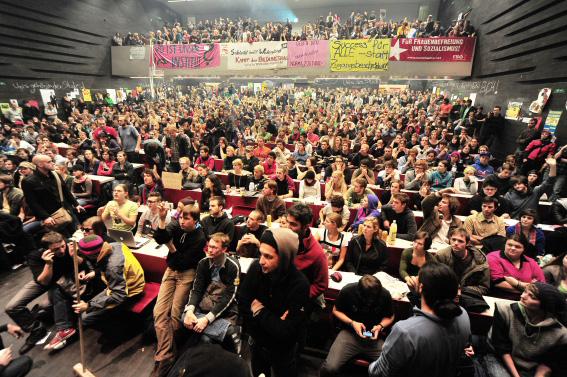The crisis of capitalism is shaking every corner of the world. Now Austria, considered in the past as a country of social peace and “dialogue”, has been hit by a massive student protest that is attracting widespread support among the workers, who are also showing signs of radicalisation.
After a hot spring with massive school student strikes and trade union protests for higher wages this autumn started with university occupations and mass demonstrations of students. Austria has reached a turning point.
In recent years we have seen a complete restructuring of the Austrian university system in line with the principles of so-called “neoliberal” ideology. In 2001 the then right-wing government coalition introduced tuition fees; in several faculties restrictions on admissions (including selective tests) were implemented. In real terms the university budget was cut to a level which makes it impossible to guarantee all students access to important lectures and seminars, the lecture rooms are overcrowded, and there are not enough university teachers to supervise all the students. On top of this the government has applied the Bologna process to the Austrian universities. This has put enormous pressure on many students who are forced to get their degree as quickly as possible. Especially for students who have to work (and this is the absolute majority) and those with children this has created severe problems.
During the last election campaign one year ago the Social Democratic Party (SPÖ) got a majority in parliament to abolish tuition fees for most students. The question of tuition fees is of enormous symbolic importance for the labour movement. The free education system was one of the biggest achievements of the SPÖ in the 1970s. The fact that the party leadership gave up its demand to abolish these fees when they re-entered a government coalition in 2007 with the conservative People’s Party (ÖVP) has led to a severe crisis within the party and the first attempts to organise a left wing within it.
The abolition of fees was seen as a big success for all those fighting for a free education system. However, at the same time the government did not increase the budget according to the needs of the universities. This in fact led to a worsening of the situation for the students because more youth saw the chance to start going to university, but with no extra spending allocated to cover for the increased numbers. Even the OECD and the EU put pressure on Austria to increase the share of the federal budget on education from 1.2% to 2% of GDP. This would mean pumping at least a further one billion Euros into the universities, which is nearly 50 per cent of the present budget of the universities.
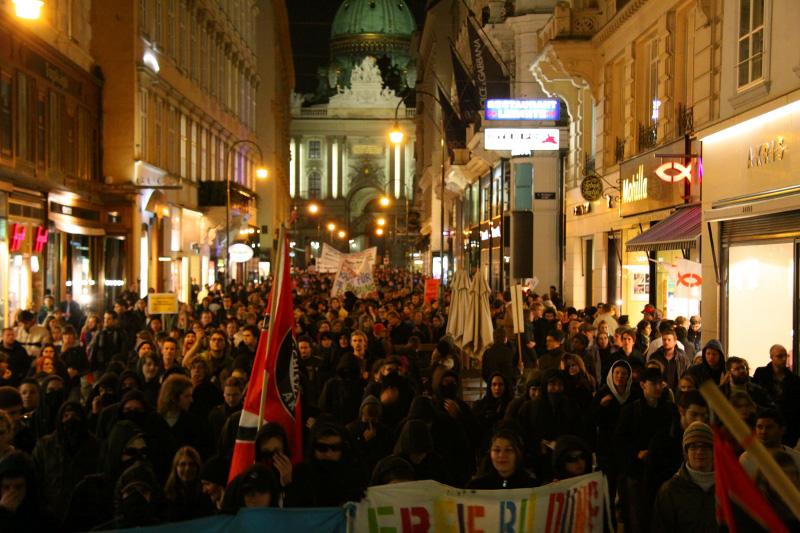 Demonstration on October 28 in Vienna. Photo by #unibrennt on flickr. All this has led to a very explosive situation. However, everybody had thought that the students would continue to accept this counter-reform. Indeed, after the defeat in the struggle against the introduction of tuition fees in 2001 the student movement was on a low ebb. Many activists were frustrated and simply tried to put their heads down and get their degrees. The university students searched for an alternative in “autonomous ideas” raising the model of “grassroots democracy”. This was, in effect, a reaction to the role of the official students’ representative bodies which ignored the real movement and were responsible for the defeats of the past. The vast majority of students had become accustomed to seeing their years at university only as a necessary step towards finding a job later on, and nothing else. The old picture of students as a force of continuous rebellion against the existing order, reading Marx and wearing t-shirts with Che Guevara appeared dead. Everybody talked of the depoliticisation of the universities.
Demonstration on October 28 in Vienna. Photo by #unibrennt on flickr. All this has led to a very explosive situation. However, everybody had thought that the students would continue to accept this counter-reform. Indeed, after the defeat in the struggle against the introduction of tuition fees in 2001 the student movement was on a low ebb. Many activists were frustrated and simply tried to put their heads down and get their degrees. The university students searched for an alternative in “autonomous ideas” raising the model of “grassroots democracy”. This was, in effect, a reaction to the role of the official students’ representative bodies which ignored the real movement and were responsible for the defeats of the past. The vast majority of students had become accustomed to seeing their years at university only as a necessary step towards finding a job later on, and nothing else. The old picture of students as a force of continuous rebellion against the existing order, reading Marx and wearing t-shirts with Che Guevara appeared dead. Everybody talked of the depoliticisation of the universities.
However, at the end of October all this changed overnight. It all started as a protest of the students of the Academy of Fine Arts on October 20. This is the only university which still has not adopted the Bologna process, and the students started to occupy their university to prevent this from happening. On the following day students from the University of Vienna organised a demonstration in solidarity with them, and out of this emerged the idea of occupying the Auditorium Maximum (the Great Hall). It was a genuinely spontaneous movement and none of those present were sure about the outcome of this sudden eruption. From the very beginning this occupation received massive support and it was decided to continue with it “until all our demands are fulfilled”.
In the beginning the university authorities wanted to put a stop to this protest by sending in the police. But there were too many students already involved, so they had to back down. Since then the movement has spread to all universities all over Austria. Everywhere students have occupied the main lecture halls and transformed them into the centre of the movement. The students have organised in work groups which are then responsible for mobilisation, press, the “people’s kitchen”, solidarity, etc. The results of the discussions in the work groups are then reported to the daily plenary meetings.
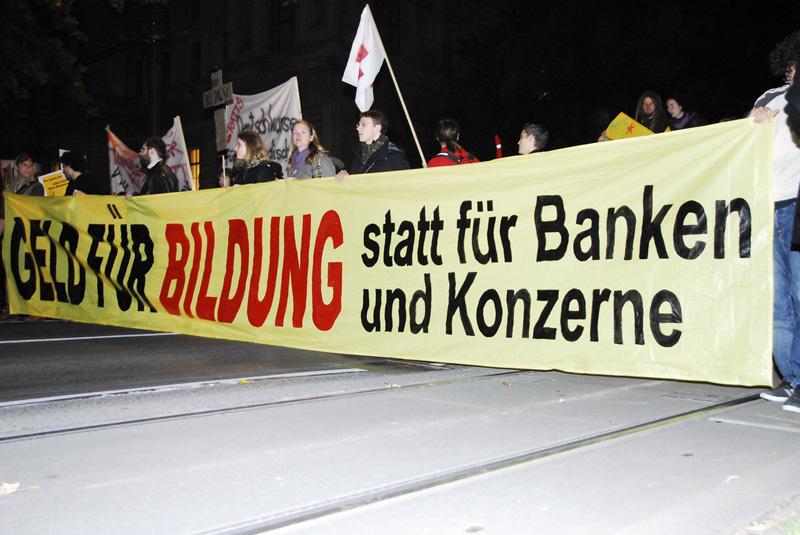 Demonstration on October 28 in Vienna: “Money for education not for the banks and big business”. Photo by #unibrennt on flickr. During the first days it was like a big party, attracting lots of students and also people from outside the universities. As time has gone by, the students have become a point of reference for all those looking for a political alternative. Especially within the trade unions there is massive support for the students and their struggle for free education. The metal workers’ union and the printers’ union, which themselves are involved in bitter conflicts over wages, immediately expressed their solidarity and offered help to organise the protests at the universities. In response, the students have declared their solidarity with the unions. This is of huge significance and is a great step forward, considering that in the past the students saw no need for joint action with the unions and even when they accepted this idea there was no concrete way of implementing it. Now it is different, and it can be a decisive difference.
Demonstration on October 28 in Vienna: “Money for education not for the banks and big business”. Photo by #unibrennt on flickr. During the first days it was like a big party, attracting lots of students and also people from outside the universities. As time has gone by, the students have become a point of reference for all those looking for a political alternative. Especially within the trade unions there is massive support for the students and their struggle for free education. The metal workers’ union and the printers’ union, which themselves are involved in bitter conflicts over wages, immediately expressed their solidarity and offered help to organise the protests at the universities. In response, the students have declared their solidarity with the unions. This is of huge significance and is a great step forward, considering that in the past the students saw no need for joint action with the unions and even when they accepted this idea there was no concrete way of implementing it. Now it is different, and it can be a decisive difference.
On Wednesday, October 28, the student mobilisations culminated in a first demonstration of tens of thousands in Vienna. The police gave a figure of 15,000 participants, whereas independent sources estimated that 30-40,000 people marched under the slogan “Money for education not for the banks and big business”. And it was not only students who turned up; there were also many workers. This was a real show of strength and has shown the potential to force the government to make concessions.
Indeed, on the following day the Conservative Minister for Science, who is in charge of the universities, offered 34 million Euros to solve the biggest problems and offered talks to the official student representative bodies which have in fact not play any role in this movement up till now. This was a clear attempt to divide the movement in the hope that the occupations would lose support. But the students are sticking to their demand for at least a billion for the education system.
What is interesting is the reaction of the SPÖ leadership towards this conflict. After the huge demonstration, chancellor Werner Faymann (SPÖ) and other Social Democratic ministers expressed their “sympathy” with the student protests. But then they came up with the “solution” of proposing stricter rules for limiting admissions to university. This goes completely against the Social Democratic idea of a free education system and also the policy of supporting young people from working class families to go to university. So, this way of showing “sympathy” once again led to an outburst of anger especially among many Young Socialists.
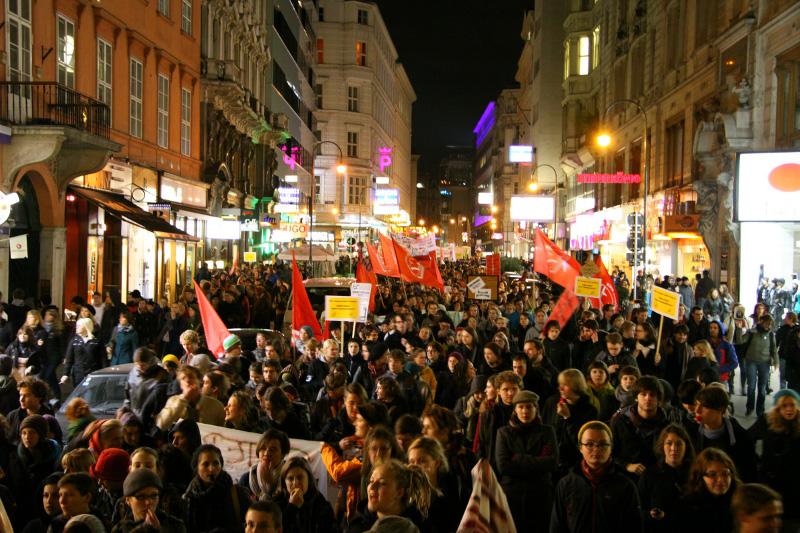 Demonstration on October 28 in Vienna. Photo by #unibrennt on flickr. This student movement has big potential. All the anger and frustration which has dominated for years has now been transformed into open resistance. Thousands of students are participating in plenary meetings, hundreds in alternative lectures. For example, this week’s Marxist study circle organised by “Der Funke” attracted some 30 students discussing Marxist philosophy.
Demonstration on October 28 in Vienna. Photo by #unibrennt on flickr. This student movement has big potential. All the anger and frustration which has dominated for years has now been transformed into open resistance. Thousands of students are participating in plenary meetings, hundreds in alternative lectures. For example, this week’s Marxist study circle organised by “Der Funke” attracted some 30 students discussing Marxist philosophy.
Then we also have the huge solidarity from outside the universities – especially from the trade unions. While we write this article the Vorarlberg Socialist Youth has held a demonstration with several hundred school students in solidarity with the university protests.
The central debate now is how to continue the struggle and how to organise the movement. The ideas of “grassroots democracy” are very dominant at this stage of the movement. Many of the occupied lecture halls (especially the AudiMax in Vienna) have turned into real laboratories for anarchism and autonomous thinking. For many activists the “method” has become the main aim in itself. The occupation for them is mainly about creating “Freiräume”, i.e. “free space”. The struggle for a better and free education system for these activists has become a secondary question.
On the one hand it is really impressive how the students have organised themselves. There is a so-called “people’s kitchen” cooking three free hot meals every day for everybody taking part in the occupations. Another work group has installed a video live stream from the plenary discussions; others are responsible for solidarity work, agitation and propaganda etc. Last weekend students cleaned the whole university. In this microcosm students are demonstrating the big potential and creativity once we are not forced to work under the alienated conditions of capitalism. This experience explains also why so many people have been deeply moved by this protest and are showing their solidarity.
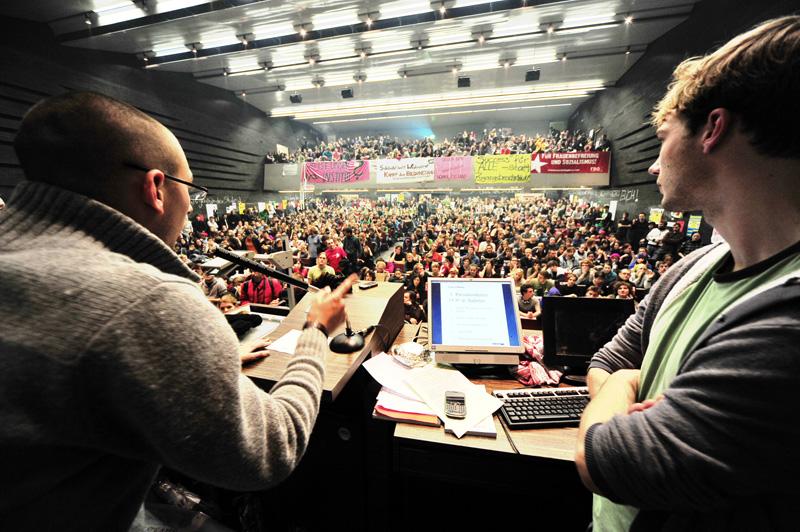 Students occupying the main lecture hall of the University of Vienna. Photo by Peter Fuchs, APEX. On the other hand, concentrating on so-called “grassroots democracy” has prevented the movement from developing a clear perspective. Endless discussions and no clear structures paralyse the movement. The fact that there is no strike action at the universities makes it very difficult for many students to take part in the discussions. Most students have to go to their courses and have to earn a living at the same time. In the work groups and plenary discussions a minority of full-time activists are dominating the scene. On several occasions one plenary took a decision and on the next day the discussion started again because new people were taking part. There is a lot of scepticism against electing a political leadership. Many students fear that then a leadership would take over this movement and they would then have no right to take part in the decision-making process. However, as in all these “grassroots experiments” we can see also in this movement that informal structures and hierarchies tend to develop. Indeed, there is actually a lack of democracy that weakens the movement.
Students occupying the main lecture hall of the University of Vienna. Photo by Peter Fuchs, APEX. On the other hand, concentrating on so-called “grassroots democracy” has prevented the movement from developing a clear perspective. Endless discussions and no clear structures paralyse the movement. The fact that there is no strike action at the universities makes it very difficult for many students to take part in the discussions. Most students have to go to their courses and have to earn a living at the same time. In the work groups and plenary discussions a minority of full-time activists are dominating the scene. On several occasions one plenary took a decision and on the next day the discussion started again because new people were taking part. There is a lot of scepticism against electing a political leadership. Many students fear that then a leadership would take over this movement and they would then have no right to take part in the decision-making process. However, as in all these “grassroots experiments” we can see also in this movement that informal structures and hierarchies tend to develop. Indeed, there is actually a lack of democracy that weakens the movement.
The Marxists of “Der Funke” within the student movement have argued from the very beginning for the election of delegates in all universities and institutes and for a “strike council” which is should be recallable at all times. This strike council should have the right to speak for the movement and the duty to develop proposals on how the movement should be built and indicate a way forward for the movement, and all this should be discussed and voted on in the plenary meetings.
There is the big danger that the movement dies down because it is not able to develop a clear perspective and clear slogans and forms of protest where the mass of the students can really participate. Already the national day of action on 5 November revealed first signs of tiredness.
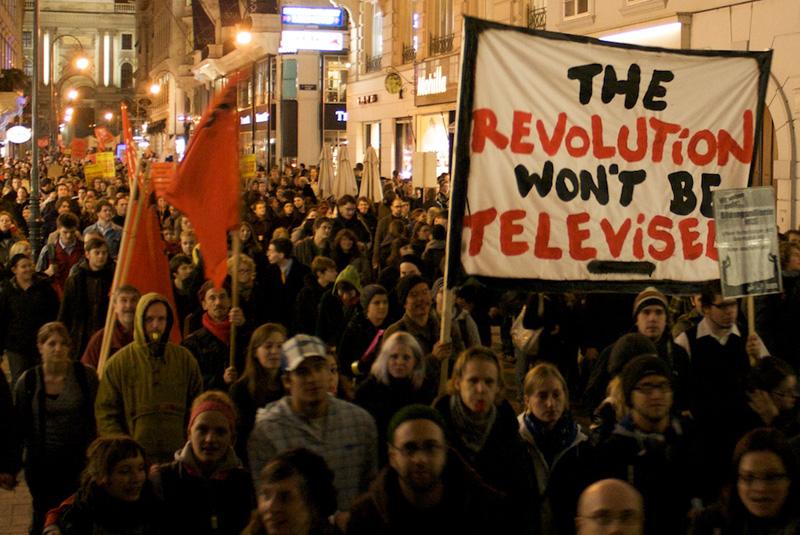 Demonstration on October 28 in Vienna. Photo by ּα on flickr. The extension of the occupations to a full all-out strike in the universities would be the only way of winning the struggle for free education that started more than three weeks ago. This would be perfectly possible because now the representation of the university teachers has declared its solidarity with the student protests. So it would be an easy job to paralyse the universities and bring the movement onto a qualitatively higher level.
Demonstration on October 28 in Vienna. Photo by ּα on flickr. The extension of the occupations to a full all-out strike in the universities would be the only way of winning the struggle for free education that started more than three weeks ago. This would be perfectly possible because now the representation of the university teachers has declared its solidarity with the student protests. So it would be an easy job to paralyse the universities and bring the movement onto a qualitatively higher level.
Furthermore, the struggle of the trade unions against wage cuts is also intensifying. On Thursday there will a demonstration in Innsbruck organised by the local trade union confederation, the metal workers’ union is also holding a rally in Vienna on the same day. In the next few days there will be a national shop stewards’ conference to discuss the next steps of this struggle.
The Marxists have been once again at the forefront in arguing for joint action between the students and the unions. The declarations of solidarity have to materialize into concrete action now. The decisive question, however, is whether the student movement can develop a clear perspective, method and joint activity with the workers.
